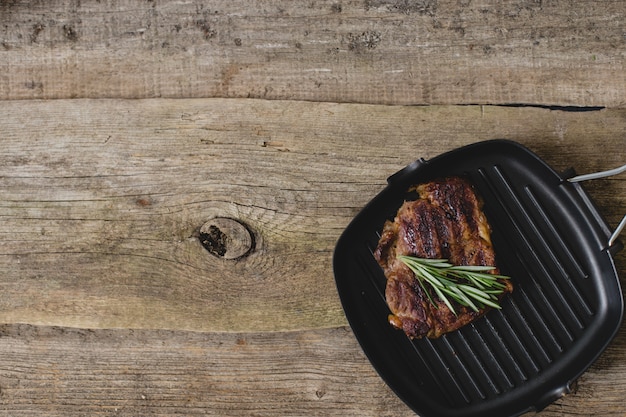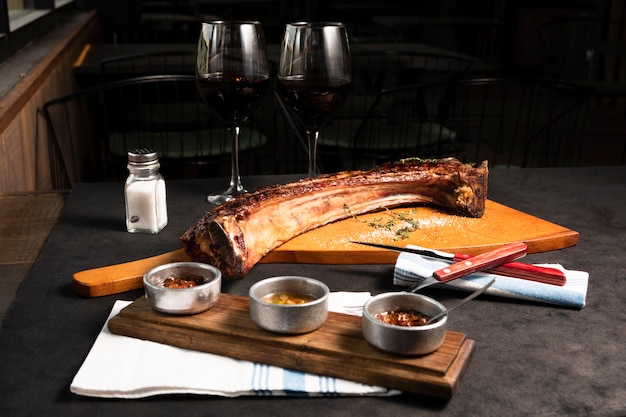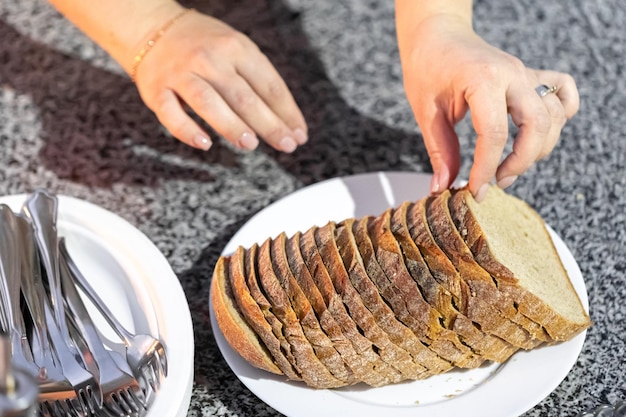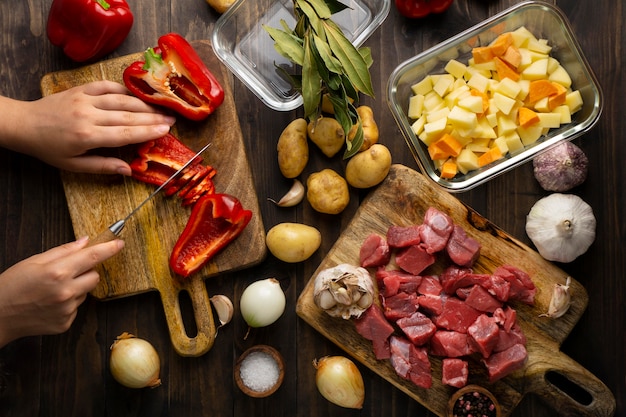Let's be honest, brisket can be a bit intimidating. All those fancy terms like "point" and "flat," and everyone talking about how long it takes to cook. But trust me, it's not as complicated as it seems. With a little patience and a trusty slow cooker, you can create a brisket that'll have your guests singing your praises.
I've been experimenting with slow cooker brisket for years, and I've learned a thing or two. I've had my fair share of dry, tough brisket, but I've also achieved melt-in-your-mouth masterpieces. I'm ready to share all my tips and tricks, from choosing the perfect cut to achieving that glorious bark. So grab a cuppa, get comfy, and let's delve into the world of slow cooker brisket together.
Part 1: The Basics of Brisket

Choosing the Right Brisket
Let's start with the most important part: picking the right cut of brisket. You've got two main options: the point and the flat. The point is the more fatty part, giving you that rich, juicy, and flavourful brisket. The flat, on the other hand, is leaner, making it a good choice if you're watching your fat intake. Personally, I'm a huge fan of the point for its melt-in-your-mouth texture and intense flavour.
When you're at the butcher counter, look for a brisket with a good amount of marbling – those streaks of fat running through the meat. Marbling is essential for a juicy and tender brisket, because the fat melts and renders as it cooks, adding incredible depth of flavour.
You'll also want to check for a good fat cap. This thick layer of fat on top helps to keep the brisket moist and prevents it from drying out during the long cooking process. It also creates a beautiful crust, or "bark," as it renders.
Preparing the Brisket
Once you've got your brisket home, it's time to give it a little TLC. The first step is to trim off any excess fat. You want a nice, even layer of fat, but too much fat will turn into a greasy mess in your slow cooker. Trim the brisket carefully, leaving about a ?? inch of fat on the top.
Now, for the fun part: seasoning! You can choose to go simple with just salt and pepper, or you can unleash your inner spice queen (or king) with a flavorful rub. I'm a big fan of a simple blend of paprika, garlic powder, onion powder, and a touch of cayenne pepper for a bit of heat. Remember, the key is to season generously, as the flavours will deepen as the brisket cooks.
Part 2: Slow Cooker Magic

The Slow Cooker Setup
Okay, time to get your trusty slow cooker out. Now, there are two main ways to place your brisket in the slow cooker: fat-side up or fat-side down. Both have their pros and cons.
- Fat-side up: This allows the fat to render and drip onto the brisket, keeping it moist. It's a great option for achieving a juicy, tender brisket.
- Fat-side down: This helps to create a beautiful crust on the bottom of the brisket. It's a good choice if you want a crispy bark.
I personally prefer to place the brisket fat-side down, as I find it tends to create a more even bark. But, ultimately, it comes down to personal preference.
Now, here's a little secret for added flavour and moisture: I like to add a cup or two of liquid to the bottom of the slow cooker. You can use beef broth, chicken broth, or even just plain water. This helps keep the brisket moist and adds a lovely base flavour. You can also use a combination of liquids, like apple cider or red wine for an extra boost of flavor.
Setting the Temperature and Time
Now, the waiting game begins! For a slow cooker brisket, you'll typically cook it on low for 8-10 hours or on high for 4-6 hours. I prefer to cook on low for a longer time, as it allows the connective tissue in the brisket to break down, resulting in melt-in-your-mouth tenderness.
It's crucial to monitor the internal temperature of the brisket to make sure it's cooked properly. Use a meat thermometer to check the temperature. The brisket is considered done when it reaches an internal temperature of 190°F (88°C).
Don't be tempted to lift the lid too often! Opening the slow cooker frequently can disrupt the cooking process and cause the temperature to drop, which can affect the cooking time.
Part 3: The Crucial Rest

Why Resting is Essential
You've put a lot of time and love into cooking this brisket. Now, it's time to give it a break! Let the brisket rest for at least 30 minutes before slicing and serving. This allows the juices to redistribute throughout the meat, resulting in a more flavourful and tender brisket. A little patience goes a long way.
Part 4: Slicing and Serving
Getting that Perfect Slice
Now, the moment of truth! Time to slice that brisket. It's best to slice against the grain, which means slicing across the muscle fibres. This will make your brisket incredibly tender and easy to chew. If you slice with the grain, you'll end up with tough, chewy slices, and nobody wants that.
Use a sharp knife to slice the brisket into thin, even slices. And remember, the slices don't have to be perfect. Just relax and enjoy the process.
Serving Up Your Masterpiece
Finally, it's time to enjoy the fruits of your labour! Serve your slow cooker brisket with all your favourite sides. I love it with creamy mashed potatoes, a simple green salad, and a tangy coleslaw. You can also make a delicious gravy using the pan juices from the slow cooker. Just strain the juices and thicken them with cornstarch or flour.
And don't forget, a good cold beer or glass of red wine always goes down well with brisket.
Part 5: Troubleshooting
Dealing with a Dry Brisket
We've all been there: you're excited to dig into your brisket, but it turns out a bit dry. Don't despair! There are ways to fix it. First, make sure you're using a brisket with enough marbling. Second, don't overcook it. If your brisket is a bit dry, try adding a bit of liquid to the slow cooker during the last hour of cooking. You can also try wrapping the brisket in foil for the last 30 minutes of cooking to help retain moisture.
Fixing a Tough Brisket
A tough brisket is a real bummer. This usually happens if you haven't cooked it long enough or if the meat is too lean. While it's tempting to keep cooking it longer, that can make it even drier. Instead, try shredding it and adding it to a dish like chili, tacos, or a BBQ sandwich.
Addressing a Lack of Bark
Want a beautiful, crispy bark? You need to cook it low and slow, allowing the fat to render and the meat to develop a crust. If your brisket doesn’t have much bark, try searing it over high heat in a skillet for a few minutes before adding it to the slow cooker. You can also try brushing it with a sauce towards the end of cooking.
Part 6: Variations on the Theme
Slow Cooker Brisket with bbq sauce
Love a good BBQ sauce? Then this one’s for you! You can add your favourite BBQ sauce during the last hour of cooking. You can also make a delicious BBQ sauce from scratch using ingredients like tomato sauce, brown sugar, vinegar, and spices. It's a great way to add a smoky, tangy flavour to your brisket.
Slow Cooker Brisket Tacos
Tacos, tacos, tacos! I love a good brisket taco. Shred the cooked brisket and serve it in warm tortillas with your favourite toppings, like onions, cilantro, salsa, and guacamole. It's a fantastic option for a casual meal.
Slow Cooker Brisket Chili
Who doesn’t love a warming bowl of chili on a cold day? Add the shredded brisket to a pot of your favourite chili recipe for a hearty and flavorful meal. You can also make a brisket chili in the slow cooker itself, just make sure to add enough liquid.
Part 7: Tips and Tricks
Using a Meat Thermometer
You want a juicy, tender brisket, right? Then a meat thermometer is your new best friend! It helps ensure that your brisket is cooked to the perfect internal temperature. Aim for an internal temperature of 190°F (88°C) for a brisket that's fall-apart tender.
Choosing the Right Slow Cooker
The size of your slow cooker will depend on the size of the brisket. A 6-quart slow cooker is ideal for a 3-4 pound brisket. If you're making a larger brisket, you might need a larger slow cooker.
Storing and Reheating Leftovers
Have leftovers? Great! Store the brisket in an airtight container in the refrigerator for up to 4 days. To reheat, simply place the brisket in a preheated oven at 350°F (175°C) until warmed through. You can also reheat it in the microwave, but it may become a bit drier.
Part 8: FAQs
1. How long does it take to cook a brisket in a slow cooker?
It typically takes 8-10 hours on low or 4-6 hours on high. You can also cook it for a shorter time if you're using a smaller brisket or prefer a less tender result.
2. What kind of brisket is best for slow cooking?
Both the point and the flat are good options, but the point is often preferred for its juicier texture and richer flavour.
3. Can I add sauce to the slow cooker while cooking?
You can add BBQ sauce or other sauces during the last hour of cooking to add flavour and moisture.
4. What are some good sides to serve with brisket?
Mashed potatoes, coleslaw, green beans, cornbread, and baked beans are all great sides for brisket.
5. What do I do if my brisket is dry?
If your brisket is a bit dry, try adding a bit of liquid to the slow cooker during the last hour of cooking. You can also try wrapping the brisket in foil for the last 30 minutes of cooking to help retain moisture.
Right, I hope this guide has helped you take the leap and try your hand at slow cooker brisket. It’s a truly satisfying experience, and I promise, you won’t be disappointed! Happy cooking, folks!
Everyone is watching

Perfect Rice Every Time: The Ultimate Guide to Cooking Rice
Cooking TipsAs a self-proclaimed foodie, I've always been a bit obsessed with rice. It's the foundation of countless cuisi...

Ultimate Guide to Cooking the Perfect Thanksgiving Turkey
Cooking TipsThanksgiving. Just the word conjures up images of overflowing tables laden with delicious food, the scent of r...

The Ultimate Guide to Cooking Asparagus: Tips, Techniques, and Recipes
Cooking TipsAsparagus. The mere mention of this spring delicacy conjures up images of vibrant green spears, crisp and burs...

Can You Cook Spaghetti with Gasoline? (The Shocking Truth)
Cooking TipsWe've all seen those crazy internet trends. You know, the ones that make you wonder, "Did someone actually try...

Chorizo and Eggs Recipe: The Ultimate Guide
Cooking TipsRight, let’s talk about chorizo and eggs. You know, that classic Spanish dish that's always a winner. It's th...
